The Lenovo ThinkStation P900 Workstation Review: Design 101
by Ian Cutress on May 6, 2015 7:00 AM ESTProfessional Performance: Linux
Linux-Bench: link
Built around several freely available benchmarks for Linux, Linux-Bench is a project spearheaded by Patrick at ServeTheHome to streamline about a dozen of these tests in a single neat package run via a set of three commands using an Ubuntu 11.04 LiveCD. These tests include fluid dynamics used by NASA, ray-tracing, OpenSSL, molecular modeling, and a scalable data structure server for web deployments. We run Linux-Bench and have chosen to report a select few of the tests that rely on CPU and DRAM speed.
C-Ray: link
C-Ray is a simple ray-tracing program that focuses almost exclusively on processor performance rather than DRAM access. The test in Linux-Bench renders a heavy complex scene offering a large scalable scenario.
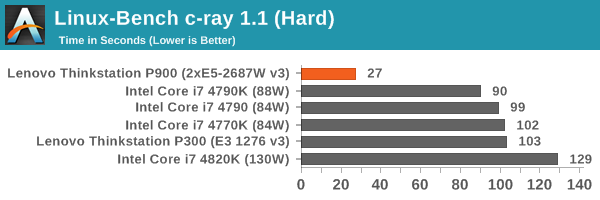
C-Ray doesn't have to deal with inter-CPU transfers or DRAM snooping, resulting in a good score.
NAMD, Scalable Molecular Dynamics: link
Developed by the Theoretical and Computational Biophysics Group at the University of Illinois at Urbana-Champaign, NAMD is a set of parallel molecular dynamics codes for extreme parallelization up to and beyond 200,000 cores. The reference paper detailing NAMD has over 4000 citations, and our testing runs a small simulation where the calculation steps per unit time is the output vector.
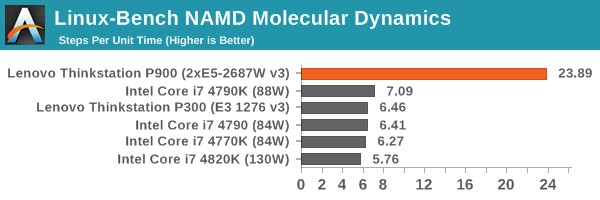
The NAMD libraries are designed to minimise any cross-CPU talking in order to extract performance out of an Intel system. As a result, we get a great result.
NPB, Fluid Dynamics: link
Aside from LINPACK, there are many other ways to benchmark supercomputers in terms of how effective they are for various types of mathematical processes. The NAS Parallel Benchmarks (NPB) are a set of small programs originally designed for NASA to test their supercomputers in terms of fluid dynamics simulations, useful for airflow reactions and design.
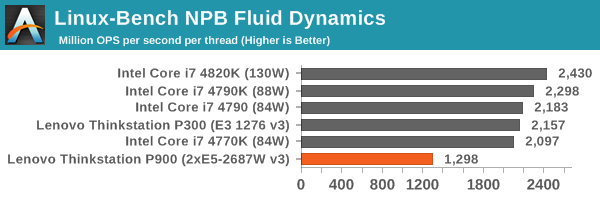
NPB gives a rather low score, based on millions of operations per second and per thread. As a result, a 40 thread system would easily outperform here, but the results are an indication of efficiency per thread.
Redis: link
Many of the online applications rely on key-value caches and data structure servers to operate. Redis is an open-source, scalable web technology with a b developer base, but also relies heavily on memory bandwidth as well as CPU performance.
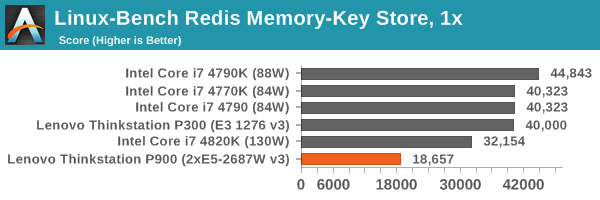
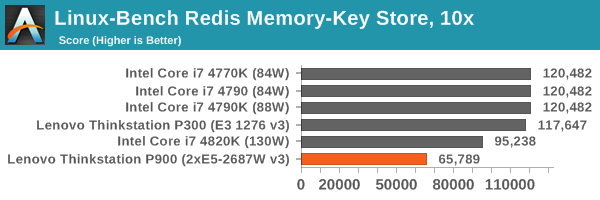

Redis prefers single socket systems almost exclusively, and as a result despite having DDR4-2133 in the P900, the cross-talking for the database takes a hit in the result.










61 Comments
View All Comments
extide - Wednesday, May 6, 2015 - link
There are plenty of apps that benefit from 2P, are you just being ignorant?Refuge - Wednesday, May 6, 2015 - link
Don't like the fan connectors, it is all too proprietary, this would be an I.T. Dept. worst nightmare in the long run, expensive to purchase, and short lived.Lenovo should know better...
GTVic - Wednesday, May 6, 2015 - link
That is one connector of 3 and I'd assume the connector shown is an adapter and the fan has a regular connector that plugs into the grey adapter.Ammaross - Wednesday, May 6, 2015 - link
Anyone else notice that the images on page 1 say "Embargoed until August 12th"?Ammaross - Wednesday, May 6, 2015 - link
2013 copyright. Nevermind. :PDiHydro - Wednesday, May 6, 2015 - link
311 watts at the wall with a 1.3 kW PSU? Good thing that PSU is 90% efficient at 20% load! The whole system only has a TDP of 470 Watts. While I understand they want more power available for HDDs and add in GPUs, the PSU seems over spec'd. How was this system loaded?der - Wednesday, May 6, 2015 - link
What a station this is! Haha!ectoplasmosis - Wednesday, May 6, 2015 - link
At the risk of sounding like a cliche, Apple did a better job of the whole baffled, segmented cooling, modular industrial engineering with the Power Mac G5 all of twelve years ago.Plus their casing still looks and feels sexy today, unlike this monstrosity full of ill-fitting moulded plastic...
Even SGI boxes of 20 year vintage had more aesthetic mystique to them.
GTVic - Wednesday, May 6, 2015 - link
It is designed to move the air, who cares what it looks like. This isn't a gaming machine with plexiglass panels and mood lighting.Zak - Wednesday, May 6, 2015 - link
Can we please get better quality photos in these reviews? Please?